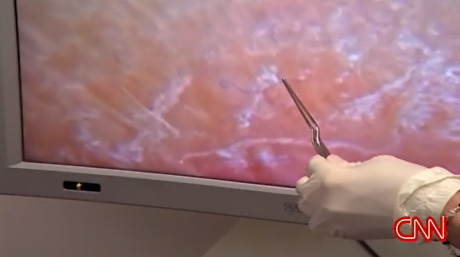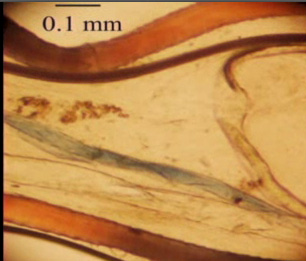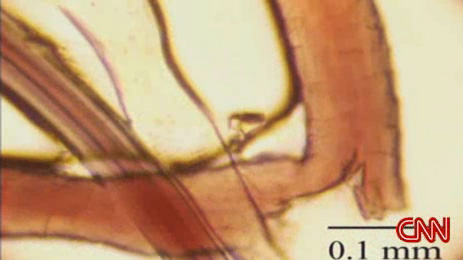Thrips are tiny winged insects, around 1mm (1/32th of an inch) long.
This is what they look like, life sized (on a leaf, look closely):

And here is what they look like under a microscope
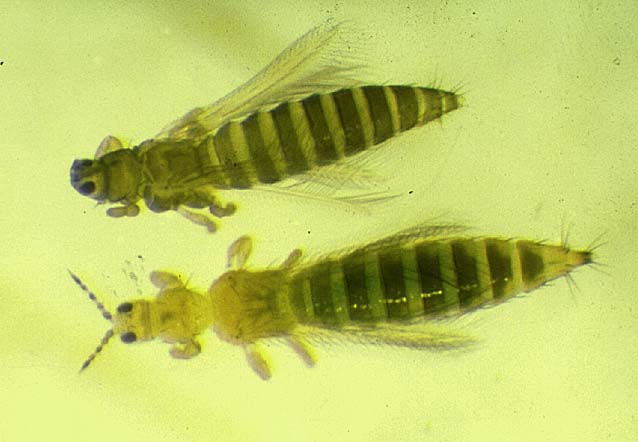
Here’s a photo of some thrips that a Morgellons believer found on her skin:
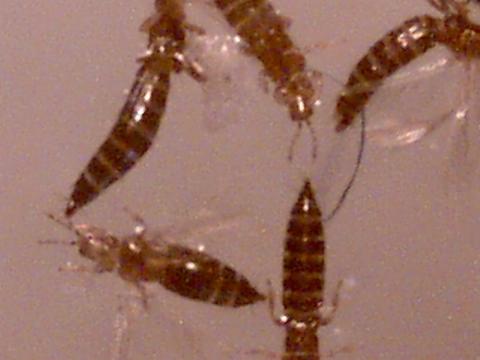
(Compare the one at the bottom left with the one in the previous picture)
Thrips infest plants. A serious infestation can have hundreds, even thousands, of thrips in a plant. Sometimes thrips swarm, they fly, and can land on your skin and bite, which can be painful. They can apparently even create lesions that they can get inside, a condition described as Thysanoptera dermatitis.
So suppose you had a thrips infestation, perhaps just on a houseplant, or perhaps you live in an agricultural area, or you have an orchard. Thrips are tiny (they can easily get through a normal window screen) and very hard to see when they are in the air. If you are closely inspecting your skin, then when the thrips land on your skin, it will be difficult to see where they came from. If you have a fertile imagination, it might look like they have emerged from your unbroken skin.
Now within the Morgellons community, there are mixed opinions as to the involvements of insects in the disease. The opinions fall thusly:
1) There are no insects involved with Morgellons, and people should stop talking about them.
2) Insects are not part of Morgellons, but it suppresses your immune system enough to allow insects to nest in your skin.
3) Morgellons is an insect infestation, the insects either create the fibers, or use clothing fibers to create cocoons, and that’s what we should talk about
4) Insects are part of the Morgellons syndrome, but we should not talk about it, as it will get us labeled as suffering from Delusions of Parasitosis.
In its doctor approved “Case Definition“, the Morgellons Research Foundation says:
“The sensations are at times related to the presence of easily seen insects”
On Lymebusters (the online forum that the MRF recommends), the thread entitled “Morgellons, (collembola?)” sums up the every shifting attitudes of some Morgellons believers.
O
It distresses me every time that morgellons is referanced to insects –such as insects crawling out of the body—this tangent can really confuse those who are trying to understand the morgellon syndrom..I have NEVER, in any remote way, made any observance of bugs-flies-etc exiting my body or crawling underneath my skin…
P
The insect theory can be harmful to us if not presented in the correct manner. I believe there is an indirect connection, phermonally speaking […]
Q
Those that have the insects hatching are suffering a very bad aspect of this – they need so much support and especially to be believed and not rejected.
P
We never told anyone they couldn’t talk about it and I apologize again if it sounded that way. We just didn’t want people to place the main emphasis of this disease’s symptoms on that aspect of it, since that is where our skeptics are getting their ammunition to dismiss us.
Q
But to disarm skeptics, any mention of insects should include the fungal / various causes aspect. Any skeptic that can’t figure out that insects and fungus can be connected is A) not too bright B) has an agenda/sponsor or C) works at UoG
O
I wish to clarify my stance–no doubt that insects can lay eggs and hatch out of the hide-skin-of many animals—
H
My theroey is that the Morg attracts other parrasites. I have personally whatched a fly hatch and fly out of my leg and watched a white furry bug eat its way into my heal,
O
We all have fibers–etc=====or defined as morgellons,some have this manifestation others some other presentation..we can not define it down to say morgellons is caused by this or that—this is what I see–That is what you see–but we all see fibers, right?SOO, I ask, why are the fibers created by so many different things?
Here’s how one of the administrators of Lymebusters (who has posted his own photos of Thrips) explains his own pro-insect belief, and the diversity of what people are seeing.
AH
[…]every time I would get bit by something in the spot where I got bit there would be a fuzzball most of the time they were the color of the article of clothing in the area that that I found the fuzzball in If I was wearing white socks they would be white or if I had something red or blue the fuzzball would be likewise I cant speak for my comrade cult members but I think that the critters that are responsible gather the fibers around them like a cocoon
[…]
And I am not saying that we all have the same thing but there is a common denominator that we all have –and that is Doctors are giving us all a bogus diagnosis that we are stuck with so we unite under the same banner to fight it
(Note that AH is just joking here, when referring to the “cult”, he’s referring to another recent post)
So what is the problem with Thrips?
The problem is the assumption, almost the dogma, amongst Morgellons believers, that they all have the same “thing”. That there is some new pathogen that they all are infected with that causes all of their symptoms. Any new symptom that someone professes to have gets included in the long list of symptoms that are allowed under Morgellons. Anything too outrageous or unique gets explained as a product of a suppressed immune system. Any mental issues get explained as neurological effects of “this disease”.
The problem with that is that they obviously don’t all have the same thing. They have a wide range of symptoms. The one thing they supposedly have in common, the fibers, vary as much as the symptoms. On the question of insects – some have them, and some don’t. Again, some believers explain this as the insects taking advantage of a compromised immune system. But you can explain anything as the result of a compromised immune system.
The trouble with Thrips is that believers unquestioningly accepted that tiny bugs can be hatched in their adult form directly through your skin, if you have Morgellons. If you have Morgellons almost anything can be accepted, no matter how outrageous. The key thing many Morgellons believers want is “to be believed”. By being part of a community that wants to be believed, they support each other, and hence they believe each other, easily glossing over all inconsistencies.
Unfortunately, by believing everyone and everything, some of them abdicate reason, and this gets in the way of them receiving appropriate treatment for their very real health issues.




